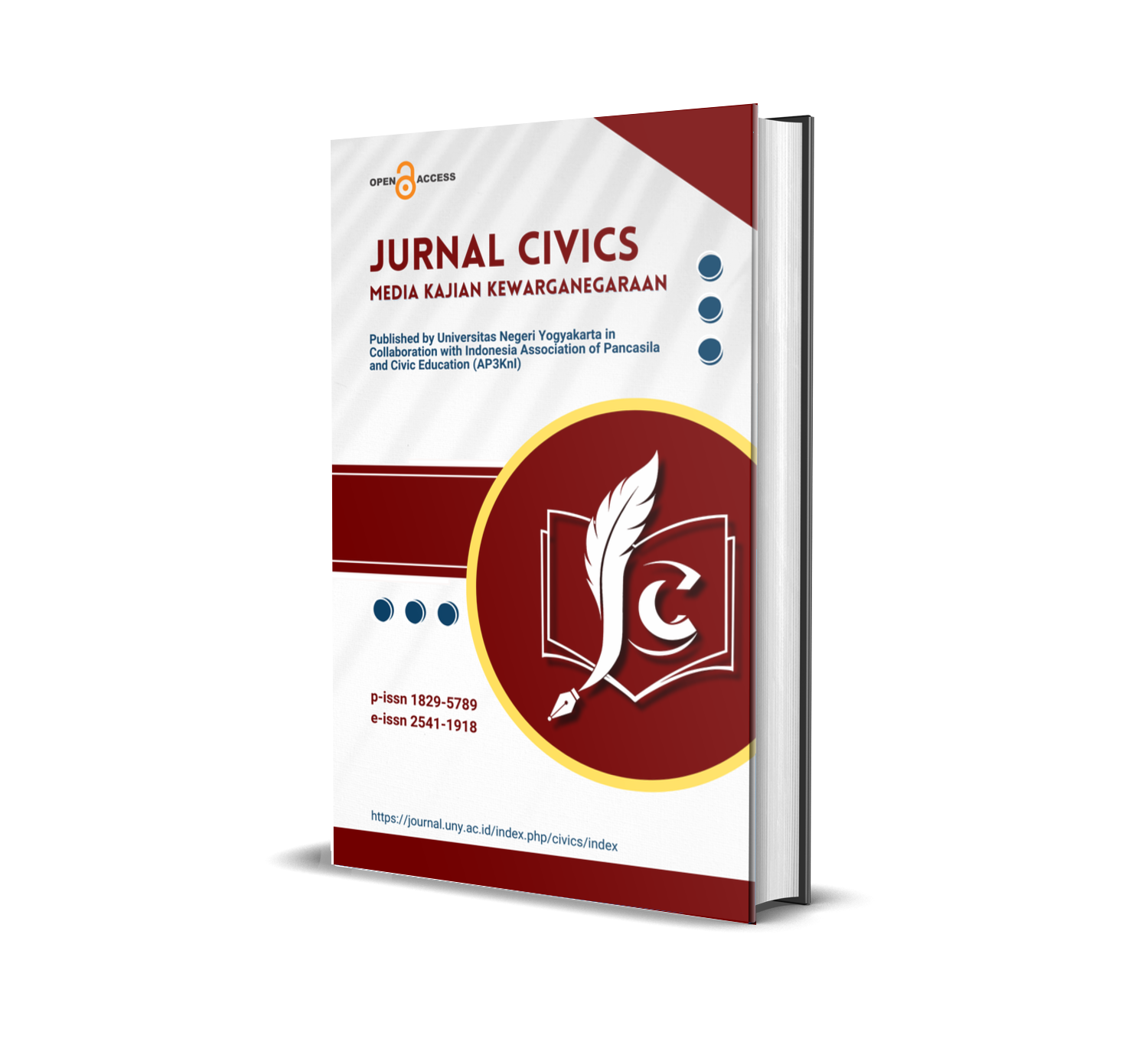The sociocultural basis of Indonesian philanthropy: Keeping citizens willing to share amid a pandemic
DOI:
https://doi.org/10.21831/jc.v18i2.44155Keywords:
philanthropy, civic education, charity, pandemic, citizensAbstract
This article aims to dig deeper into the concept of Indonesian philanthropy in dealing with the pandemic seen from the social base of the Indonesian people. This study uses a qualitative approach with the grounded theory method. This research results show a collective awareness of Durkheim's understanding that characterizes mechanical solidarity; in the case of philanthropy in Indonesia, it is at the intersection of mechanical and organic solidarity. The strengthening of generosity can be explained from the theory of social facts that there are non-material social facts that shape the spirit of the Indonesian people's philanthropic movement, namely generosity and collective awareness that characterize mechanical solidarity in rural areas that occurs in modern society with organic solidarity.
References
Barman, E. (2017). The social bases of philanthropy. Annual Review of Sociology, 43(1), 271–290. https://doi.org/10.1146/annurev-soc-060116-053524
Borgonovi, F. (2008). Divided we stand, united we fall: Religious pluralism, giving, and volunteering. American Sociological Review, 73(1), 105–128. https://doi.org/10.1177/000312240807300106
Burt, R. S., & Burzynska, K. (2017). Chinese entrepreneurs, social networks, and guanxi. Management and Organization Review, 13(2), 1–37. https://doi.org/10.1017/mor.2017.6
Candland, C. (2000). Faith as social capital: Religion and community development in Sothern Asia. Political Sciences, 33(3), 355–374. https://doi.org/10.1023/A:1004857811117
Christou, P., Hadjielias, E., & Farmaki, A. (2019). Reconnaissance of philanthropy. Annals of Tourism Research, 78(September), 1–12. https://doi.org/10.1016/j.annals.2019.102749
Cnaan, R. A., Kasternakis, A., & Wineburg, R. J. (1993). Religious people, religious congregations, and volunteerism in human service: Is there a link? Nonprofit and Voluntary Sector Quarterly, 503(1), 122–136. https://doi.org/https://doi.org/10.1177/089976409302200104
Daly, S. (2011). Philanthropy, the big society and emerging philanthropic relationships in the UK. Public Management Review, 13(8), 1077–1094. https://doi.org/10.1080/14719037.2011.619063
Durkheim, E. (2006). Sejarah agama (The elementary forms of the religious life) (I. R. Muzir (Penerj.); 3 ed.). IRCiSoD.
Fauzia, A. (2017). Islamic philanthropy in Indonesia: Modernization, islamization, and social justice. Austrian Journal of South-East Asian Studies, 10(2), 223–236. https://doi.org/10.14764/10.ASEAS-2017.2-6
Friese, S. (2019). Qualitative data analysis with ATLAS.ti. SAGE Publishing.
Heins, V. M., Unrau, C., & Avram, K. (2018). Gift-giving and reciprocity in global society: Introducing Marcel Mauss in international studies. Journal of International Political Theory, 14(2), 126–144. https://doi.org/10.1177/1755088218757807
Hyden, G. (1997). Civil society, social capital, and development: Dissection of a complex discourse. Studies in Comparative International Development, 32(1), 3–30. https://doi.org/10.1007/BF02696304
Kambali, M. (2020). Pemikiran Karl Marx tentang struktur masyarakat (Dialektika infrastruktur dan suprastruktur). Jurnal Pemikiran dan Penelitian Ekonomi Islam, 8(2), 63–80. https://media.neliti.com/media/publications/332489-pemikiran-karl-marx-tentang-struktur-mas-fb1b694e.pdf
Kurzban, R., Burton-Chellew, M. N., & West, S. A. (2015). The evolution of altruism in humans. Annual Review of Psychology, 66(1), 575–599. https://doi.org/10.1146/annurev-psych-010814-015355
Latief, H. (2013a). Agama dan pelayanan sosial: Interpretasi dan aksi filantropi dalam tradisi Muslim dan Kristen di Indonesia. Religi, IX(2), 174–189.
Latief, H. (2013b). Politik filantropi di Indonesia. Ombak.
Lim, C., & MacGregor, C. A. (2012). Religion and volunteering in context: Disentangling the contextual effects of religion on voluntary behavior. American Sociological Review, 77(5), 747–779. https://doi.org/10.1177/0003122412457875
Mauss, M. (2002). The gift: The form and reason for exchange in archaic societies. Taylor & Francis e-Library.
Milner, A. (2018). Lanskap global filantropi (Filantropi Indonesia (Penerj.)). Worldwide Initiatives for Grantmaker Support (WINGS).
Nepstad, S. E., & Williams, R. H. (2007). Religion in rebellion, resistance, and social movements. In J. A. Beckford & N. J. Demerath (Ed.), The SAGE handbook of the sociology of religion (hal. 419–437). SAGE Publications Ltd. https://doi.org/10.4135/9781848607965.n21
Norenzayan, A., & Shariff, A. F. (2008). The origin and evolution of religious prosociality. Science, 322(5898), 58–62. https://doi.org/10.1126/science.1158757
Payne, G. T., Moore, C. B., Griffis, S. E., & Autry, C. W. (2011). Multilevel challenges and opportunities in social capital research. Journal of Management, 37(2), 491–520. https://doi.org/10.1177/0149206310372413
Piliavin, J. A., & Charng, H. (1990). Altruism: A review of recent. Annual Review of Sociology, 16, 27–65. https://doi.org/10.1146/annurev.so.16.080190.000331
Putnam, R. D. (2001). Bowling alone: The collapse and revival of American community. Simon and Schuster.
Rogers, M., & Konieczny, M. E. (2018). Does religion always help the poor? Variations in religion and social class in the west and societies in the global south. Palgrave Communications, 4(1), 1–11. https://doi.org/10.1057/s41599-018-0135-3
Ruiter, S., & De Graaf, N. D. (2006). National context, religiosity, and volunteering: Results from 53 countries. American Sociological Review, 71(2), 191–210. https://doi.org/10.1177/000312240607100202
Seglow, J. (2002). Altruism and freedom. Critical Review of International Social and Political Philosophy, 5(4), 145–163. https://doi.org/10.1080/13698230410001702782
Smith, C. (1996). Disruptive religion: The force of faith in social-movement activism. Routledge.
Suseno, Y. (2018). Disruptive innovation and the creation of social capital in Indonesia’s urban communities. Asia Pacific Business Review, 24(2), 174–195. https://doi.org/10.1080/13602381.2018.1431251
Underwood, S. (2020). Building a better normal: What now for philanthropy? The Philanthropy Workshop. https://www.tpw.org/building-a-better-normal-what-now-for-philanthropy/
Weidel, T. (2016). Philanthropy, cosmopolitanism, and the benefits of giving directly. Journal of Global Ethics, 12(2), 170–186. https://doi.org/10.1080/17449626.2016.1196461
Williams, R. H. (2003). Religious pocial movements in the public sphere. In Handbook of the Sociology of Religion (hal. 315–330). Cambridge University Press. https://doi.org/10.1017/CBO9780511807961.022
Downloads
Published
How to Cite
Issue
Section
Citation Check
License
This work is licensed under a Creative Commons Attribution-NonCommercial-ShareAlike 4.0 International License.
The authors agree to transfer the transfer copyright of the article to The Jurnal Civics: Media Kajian Kewarganegaraan effective if and when the paper is accepted for publication.
Authors and other parties are bound to the Creative Commons Attribution-NonCommercial-ShareAlike 4.0 International License for the published articles, legal formal aspect of journal publication accessibility refers to Creative Commons Attribution-NonCommercial-ShareAlike 4.0 International License (CC BY-NC-SA).










